- Home
- About
- Map
- Trips
- Bringing Boat West
- Migration West
- Solo Motorcycle Ride
- Final Family XC Trip
- Colorado Rockies
- Graduates' XC Trip
- Yosemite & Nevada
- Colorado & Utah
- Best of Utah
- Southern Loop
- Pacific Northwest
- Northern Loop
- Los Angeles to NYC
- East Coast Trips
- Martha's Vineyard
- 1 Week in Quebec
- Southeast Coast
- NH Backpacking
- Martha's Vineyard
- Canadian Maritimes
- Ocracoke Island
- Edisto Island
- First Landing '02
- Hunting Island '02
- Stowe in Winter
- Hunting Island '01
- Lake Placid
- Chesapeake
- Provincetown
- Hunting Island '00
- Acadia in Winter
- Boston Suburbs
- Niagara Falls
- First Landing '99
- Cape Hatteras
- West Coast Trips
- Burning Man
- Utah Off-Roading
- Maui
- Mojave 4WD Course
- Colorado River Rafting
- Bishop & Death Valley
- Kauai
- Yosemite Fall
- Utah Off-Road
- Lost Coast
- Yosemite Valley
- Arizona and New Mexico
- Pescadero & Capitola
- Bishop & Death Valley
- San Diego, Anza Borrego, Joshua Tree
- Carmel
- Death Valley in Fall
- Yosemite in the Fall
- Pacific Northwest
- Utah Off-Roading
- Southern CA Deserts
- Yosemite & Covid
- Lake Powell Covid
- Eastern Sierra & Covid
- Bishop & Death Valley
- Central & SE Oregon
- Mojave Road
- Eastern Sierra
- Trinity Alps
- Tuolumne Meadows
- Lake Powell Boating
- Eastern Sierra
- Yosemite Winter
- Hawaii
- 4WD Eastern Sierra
- 4WD Death Valley +
- Southern CA Deserts
- Christmas in Tahoe
- Yosemite & Pinnacles
- Totality
- Yosemite & Sierra
- Yosemite Christmas
- Yosemite, San Diego
- Yosemite & North CA
- Seattle to Sierra
- Southwest Deserts
- Yosemite & Sierra
- Pacific Northwest
- Yosemite & South CA
- Pacific Northwest
- Northern California
- Southern Alaska
- Vancouver Island
- International Trips
- Index
- Tips
- Books
- Photos/Videos
- Search
- Contact
Capitol Reef National Park
Wednesday, May 28, 2025 - 6:15pm by Lolo75 miles and 2 hours from our last stop - 2 night stay
Travelogue
The TeePee Saga
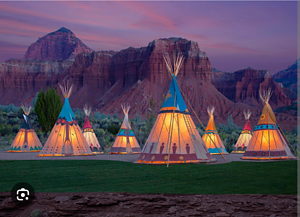 The ad that drew me inBefore leaving on this trip, this ad popped up on my FB page for a teepee glamping experience in Capitol Reef where we planned to go along our Utah trip. “Doesn’t that look so awesome?” I asked Herb. We do have this agreement on off-road trips that after 2 or 3 nights of camping, I get a nice hotel with hot shower and porcelain toilet, so he faked some enthusiasm and told me to book two nights so we could do the hike to Navajo Knobs in the park.
The ad that drew me inBefore leaving on this trip, this ad popped up on my FB page for a teepee glamping experience in Capitol Reef where we planned to go along our Utah trip. “Doesn’t that look so awesome?” I asked Herb. We do have this agreement on off-road trips that after 2 or 3 nights of camping, I get a nice hotel with hot shower and porcelain toilet, so he faked some enthusiasm and told me to book two nights so we could do the hike to Navajo Knobs in the park.
When the day had finally arrived, I called en route there to see if by any chance we could have an early check in, and was told that our teepee was ready whenever we arrived. However, they did suggest that we might might want to spend most of the day outside the teepee, because the swamp cooler (desert kludge of an air conditioner) had a hard time bringing the temperature down in the 90 degree temperature forecast for the next two days.
 Our wonderful upgradePlus we learned that there wasn’t actually a bathroom inside the teepee, but rather one assigned just to our teepee about 30 feet away. At this point, the teepee seemed to have no advantages over sleeping in our 4 Runner.
Our wonderful upgradePlus we learned that there wasn’t actually a bathroom inside the teepee, but rather one assigned just to our teepee about 30 feet away. At this point, the teepee seemed to have no advantages over sleeping in our 4 Runner.
Enthusiasm a little dampened, we forged on. Upon entering our luxury teepee, we became a bit concerned by the 2 dozen or so mouse traps spread throughout the teepee - no customers yet, but some evidence of mouse dropping on the bed. I very much did not want to get hantavirus during my expensive, luxury glamping.
I was now depressed. Instead of the luxury glamping experience I was so looking forward to, I had reserved two expensive nights in a windowless, bathroomless, mouse-ridden sweat lodge.
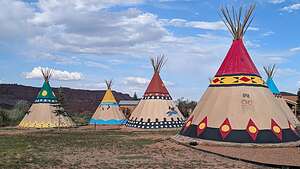 Now we could look at them from our deckHerb felt it was time to have a little discussion with the front desk, asking us if we could move to one of the cabins that also had the same great view only to be told they were all booked. What about those, Herb pointed to some very nice large cabins. They told us they were an upgrade and would cost more. To that, Herb suggested that it might be a nice gesture on their part to comp us for the difference because of the trauma his wife had been put through - actually I think Herb was more traumatized.
Now we could look at them from our deckHerb felt it was time to have a little discussion with the front desk, asking us if we could move to one of the cabins that also had the same great view only to be told they were all booked. What about those, Herb pointed to some very nice large cabins. They told us they were an upgrade and would cost more. To that, Herb suggested that it might be a nice gesture on their part to comp us for the difference because of the trauma his wife had been put through - actually I think Herb was more traumatized.
Happy Ending - we were moved to a beautiful two bedroom, two bathroom cabin, with a full kitchen and a large deck. Yeah Herb. He’s a much better negotiator than me.
That evening we walked across the street to the Rim Rock Restaurant where the food was okay, but the views of the red sandstone cliffs of Capitol Reef were excellent.
Navajo Knobs Hike
 Approaching Navajo DomeDuring our two-night stay in Capitol Reef National Park (not in a teepee), we hiked the spectacular Navajo Knobs trail, a 10-mile, fairly strenuous trail along the Waterpocket Fold to the Navajo sandstone knobs, rising above the entire park.
Approaching Navajo DomeDuring our two-night stay in Capitol Reef National Park (not in a teepee), we hiked the spectacular Navajo Knobs trail, a 10-mile, fairly strenuous trail along the Waterpocket Fold to the Navajo sandstone knobs, rising above the entire park.
The Waterpocket Fold is unique to Capitol Reef. When the earth’s crust was uplifting 65 million years ago creating many of the mountains and plateaus of the West, something different happened in this area. Rather than uplifting evenly, the crust in what is now Capitol Reef wrinkled into a 100-mile long huge fold, which tilted downwards to the east.
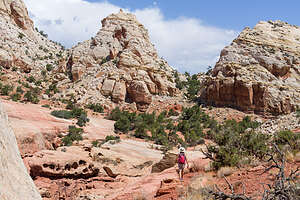 Along the Navajo Knobs TrailThis feature is what is known as a classic monocline, characterized by a step-like bend in the rock layers where the layers are tilted in one direction, in this case, to the east. The rock layers on the west side of the fold are 7,000 feet higher than the layers on the east side.
Along the Navajo Knobs TrailThis feature is what is known as a classic monocline, characterized by a step-like bend in the rock layers where the layers are tilted in one direction, in this case, to the east. The rock layers on the west side of the fold are 7,000 feet higher than the layers on the east side.
Erosion of the tilted rock layers continues today forming colorful cliffs, massive domes, soaring spires, stark monoliths, twisting canyons, and graceful arches.
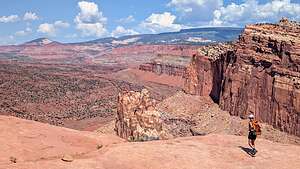 Rim OverlookMost national parks have a distinctive feature that defines them - Yellowstone has its geysers, the Grand Canyon has its canyon, Yosemite has its granite cliffs, Sequoia has its giant trees, etc.
Rim OverlookMost national parks have a distinctive feature that defines them - Yellowstone has its geysers, the Grand Canyon has its canyon, Yosemite has its granite cliffs, Sequoia has its giant trees, etc.
Well, Capitol Reef has something no other park has - a 100-mile huge wrinkle (or fold) in the earth’s crust, created when the earth’s crust was uplifted 65 million years ago.
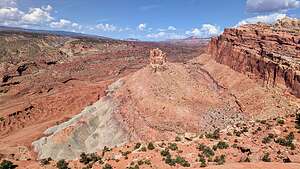 The CastleIt's essentially a tilted layer of sedimentary rock that has been bent and folded over millions of years due to tectonic forces.
The CastleIt's essentially a tilted layer of sedimentary rock that has been bent and folded over millions of years due to tectonic forces.
In geological lingo, it’s called a monocline, which is a step-like bend in the rock layers where the layers are tilted in one direction, in this case, to the east. The rock layers on the west side of the fold are 7,000 feet higher than the layers on the east side.
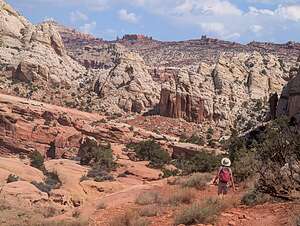 Getting closer to the KnobsSo today, we would walk the “wrinkle,” or at least 10 miles of it along the Navajo Knobs trail, a fairly strenuous trail along the Waterpocket Fold to the Navajo sandstone knobs, rising above the entire park.
Getting closer to the KnobsSo today, we would walk the “wrinkle,” or at least 10 miles of it along the Navajo Knobs trail, a fairly strenuous trail along the Waterpocket Fold to the Navajo sandstone knobs, rising above the entire park.
The hike begins at the Hickman Bridge Trailhead, about two miles east of the Capitol Reef Visitor Center.
From the trailhead we proceeded east and soon began to climb some moderately steep switchbacks.
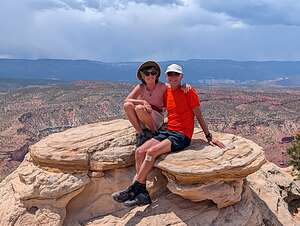 Atop the Navajo KnobsAt 0.3 miles, we came to the junction with the Hickman Bridge trail, but decided to skip that for now and continue straight towards the Navajo Knobs.
Atop the Navajo KnobsAt 0.3 miles, we came to the junction with the Hickman Bridge trail, but decided to skip that for now and continue straight towards the Navajo Knobs.
We passed the very impressive, 6,489-foot high Navajo Dome. While the predominant color of the waterpocket fold is red, some Navajo Sandstone formations, like this one, are a stark white, due to the lack of iron oxides which are found in the red rocks.
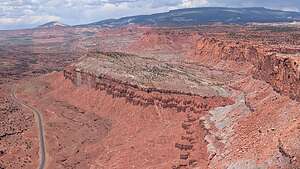 View of the Waterpocket Fold from atop the KnobsFrom the junction, we continued to ascend, stopping briefly at 0.9 miles at the Hickman Bridge Overlook, where we had a view of the natural bridge.
View of the Waterpocket Fold from atop the KnobsFrom the junction, we continued to ascend, stopping briefly at 0.9 miles at the Hickman Bridge Overlook, where we had a view of the natural bridge.
The trail then continued a steady climb along switchbacks and over slickrock until at 2.3 miles we came to the Rim Overlook, where we had stunning views of the Fruita orchards, the Visitor Center, and the surrounding white and red rock formations, including the massive Waterpocket Fold.
.thumbnail.jpg) Along the benches on the way backThis is a common turn-around point for those that prefer a moderate 4.6-mile round trip as opposed to a strenuous 10-mile round trip.
Along the benches on the way backThis is a common turn-around point for those that prefer a moderate 4.6-mile round trip as opposed to a strenuous 10-mile round trip.
I briefly thought about turning around, but then we forged on. The trail now became more challenging as it steadily and relentlessly climbed across rugged terrain and open slickrock, fortunately with plenty of rock cairns to mark our way across the slickrock.
At this point, one hiker (the first we had seen all day) passed us.
 Along the way backThe trail follows the contours of the bench, sometimes bringing us quite close to the edge of the rim with steep drop-offs.
Along the way backThe trail follows the contours of the bench, sometimes bringing us quite close to the edge of the rim with steep drop-offs.
One especially beautiful view was looking down at “The Castle,” with its grey-green base with its grey-green base, signifying the presence of ferrous iron.
The final push up to the Navajo Knobs was steep and required some rock scrambling to reach the actual top of the Knobs. This was the most people we had seen all day.
.thumbnail.jpg) Almost backThere were already a few people sitting at the top, so we waited our turn to scramble up for the incredible 360-degree views of the Waterpocket Fold and the Henry Mountains from atop the Knobs.
Almost backThere were already a few people sitting at the top, so we waited our turn to scramble up for the incredible 360-degree views of the Waterpocket Fold and the Henry Mountains from atop the Knobs.
From there, we had to retrace our steps and hike the 5 miles back to the trailhead. It was a lot tougher than it should have been because we made the major hiking faux pas of not bringing sufficient water. In fact, we completely ran out with about a mile to go.
The first thing we did when we got back to the car was grab a cold drink out of the 4Runner’s refrigerator. It was pretty stupid of us not to have taken more water as it was quite a strenuous hike - 10 miles with 2,725 elevation gain over 6.5 hours on a pretty hot day.
We sure were glad we were going back to a nice air-conditioned cabin rather than a hot teepee..
Hole-in-the-Rock Road
Monday, May 26, 2025 - 3:00pm by Lolo150 miles and 3.5 hours from our last stop - 2 night stay
Travelogue
 Devil's GardenUpon reaching Southern Utah, we left the asphalt and headed off on the Hole-in-the-Rock Road, which runs from Escalante for 62 bumpy miles to the western shores of Lake Powell.
Devil's GardenUpon reaching Southern Utah, we left the asphalt and headed off on the Hole-in-the-Rock Road, which runs from Escalante for 62 bumpy miles to the western shores of Lake Powell.
The Hole-in-the-Rock is an historical trail that retraces the route taken in 1879 by a party of 230 Mormons, 83 wagons, and 1,000 cattle, who were sent out to build a settlement on the San Juan River. They went through quite an ordeal when after 53 miles they reached the top of a cliff, with a narrow and steep crevice lending at a 45 degree angle down to what is now the Escalante Arm of Lake Powell 2,000 feet below.
The pioneers spent the entire winter working on the crack, slowly enlarging the opening with only pick axes, shovels, and small supplies of blasting powder. Finally, on January 26, 1880, the expedition slowly made its way down the precarious “road” where a ferry had been built to get them across to the eastern side of the Colorado River where there was a route for them to continue on.
We would not be doing that. I felt kind of wimpy in our comfortable 4Runner, with the air conditioning going and sandwiches and cold beer in our fridge.
Devil’s Garden
 Devil's Garden Ice Cream ConesOur first stop along the road was Devil’s Garden (at Mile 12), a wonderland of Navajo Sandstone hoodoos, domes, narrow passages and small arches, all in beige and brown.
Devil's Garden Ice Cream ConesOur first stop along the road was Devil’s Garden (at Mile 12), a wonderland of Navajo Sandstone hoodoos, domes, narrow passages and small arches, all in beige and brown.
There are no marked trails at Devil’s Garden, so we just wandered around as we pleased, sometimes passing the same hoodoo several times.
 Metate Arch in Devil's GardenThe "rocks" in Devil's Garden are primarily composed of Entrada Sandstone, which isn’t uniform in that it has variations in hardness and cementation, so some layers or parts of the rock erode faster than others. The harder, more resistant white "caprock" layer often protects the softer rock beneath it.
Metate Arch in Devil's GardenThe "rocks" in Devil's Garden are primarily composed of Entrada Sandstone, which isn’t uniform in that it has variations in hardness and cementation, so some layers or parts of the rock erode faster than others. The harder, more resistant white "caprock" layer often protects the softer rock beneath it.
Further shaping the rocks are the winds carrying sand particles, which act like a natural sandblaster, continually scouring and shaping the exposed sandstone, especially in areas where the rock is weaker. This often leads to the smooth, rounded shapes seen in the hoodoos.
Some of them looked to me like giant ice cream cones.
There was also a very cool arch, named Metate Arch, formed in a similar process of erosion as my ice cream cones. The harder caprock layer, which forms the lintel (the top arch of the arch), is more resistant to weathering and erosion, allowing it to remain intact while the surrounding softer sandstone below was removed over time by the forces of erosion.
Nature is a very good artist.
Peekaboo and Spooky Slot Canyons
 On the way to Peekaboo Slot CanyonThis is the furthest we had ever gone along the Hole-in-the-Rock Road, although we had actually seen the Hole-in-the Rock from our boat on a trip to Lake Powell. The last time we were here, but this time we were going to continue further to camp and to do some interesting hikes.
On the way to Peekaboo Slot CanyonThis is the furthest we had ever gone along the Hole-in-the-Rock Road, although we had actually seen the Hole-in-the Rock from our boat on a trip to Lake Powell. The last time we were here, but this time we were going to continue further to camp and to do some interesting hikes.
After Devil’s Garden, we continued along the Hole-in-the-Rock road to mile 26, where we turned left onto an unsigned road leading to Dry Fork Coyote Gulch. We continued on that road for 1.7 miles to the trailhead for the Peekaboo and Spooky Slot Canyon hikes.
 First view of the Slot in the distanceWe have hiked in numerous slot canyons in the past, but none quite as narrow as these. At the trailhead there were two tall metal poles about 10 inches apart and a sign that says something to the effect, if you can’t fit through these, don’t bother continuing. Herb and I passed the “tightness guide” test, but with not too much to spare.
First view of the Slot in the distanceWe have hiked in numerous slot canyons in the past, but none quite as narrow as these. At the trailhead there were two tall metal poles about 10 inches apart and a sign that says something to the effect, if you can’t fit through these, don’t bother continuing. Herb and I passed the “tightness guide” test, but with not too much to spare.
 Scary entrance into Peekaboo Slot CanyonOur plan was to do the 5.2 mile loop, going up through Peekaboo first, then across to Spooky and down through that.
Scary entrance into Peekaboo Slot CanyonOur plan was to do the 5.2 mile loop, going up through Peekaboo first, then across to Spooky and down through that.
From the trailhead we followed a cairns trail which led us across ledges where we looked down into Dry Fork Coyote Gulch, where we would descend down into and across to get to the entry for Peekaboo Canyon.
From the top of the ledges we looked across to a large slot in the cliff face, with tiny people the size of ants in front of it, lined up to do the scramble up and into Peekaboo slot canyon.
 The scary ascent goes onFrom there we descended down into and across Dry Fork Coyote Gulch to join the line of people at the slot we had looked down upon from the ledges. We had now hiked about a mile and a half.
The scary ascent goes onFrom there we descended down into and across Dry Fork Coyote Gulch to join the line of people at the slot we had looked down upon from the ledges. We had now hiked about a mile and a half.
I had heard that this was the most challenging part of the hike, but it was a lot scarier than I expected. In front of me was a smooth sandstone wall, with little to no handholds. There were a few faint steps carved into the sandstone to offer some assistance on the initial 20-foot ascent into the canyon.
I am a fairly good rock climber, but I really prefer a good handhold to a good foothold.
.thumbnail.jpg) Inside Peekaboo CanyonSeeing my discomfort, Herb helped out with the occasional butt push and also cupping his hands to make a foot hold for me.
Inside Peekaboo CanyonSeeing my discomfort, Herb helped out with the occasional butt push and also cupping his hands to make a foot hold for me.
However, he soon couldn’t reach me anymore, so I had to finish the remaining 15 feet or so of the ascent.
From there we weaved our way through the narrow, twisting passageways where the walls rose about 50 feet above us. Little did we know at the time that this canyon would feel spacious compared to Spooky.
.thumbnail.jpg) Colorful walls of Spooky Slot CanyonThe colors of the sandstone walls were a beautiful vibrant red, orange and pink with undulating curves, arches, and tunnels shifting with the changing light.
Colorful walls of Spooky Slot CanyonThe colors of the sandstone walls were a beautiful vibrant red, orange and pink with undulating curves, arches, and tunnels shifting with the changing light.
There were a few more smaller rock scrambles as we hiked up into the canyon, as the walls got shorter and wider apart.
After about a half mile of navigating through Peekaboo, the slot ended in a broad, sandy wash. From there we traversed right (east) across a low ridge for about ten minutes to enter Spooky Slot Canyon.
 Spooky Slot CanyonAt first, it didn’t seem too much narrower than Peekaboo, but then the walls began to constrict dramatically, often becoming less than 12 inches apart in some places.
Spooky Slot CanyonAt first, it didn’t seem too much narrower than Peekaboo, but then the walls began to constrict dramatically, often becoming less than 12 inches apart in some places.
Even after taking off our backpacks, we had to suck in our stomachs and twist and turn sideways to get through. I seriously wonder if anyone ever got stuck in here. It was definitely not for the heftier hiker nor for one with claustrophobia.
Like Peekaboo, the smooth, wave-like patterns and swirling colors of the Navajo sandstone were breathtaking. As the indirect light filtered down, the walls turned red, orange, and gold.
 Things were starting to get tightThere were a lot more challenging obstacles to conquer in Spooky. In addition to the rock scrambling we expected, we often had to stem (bracing our feet on opposite walls to move forward.
Things were starting to get tightThere were a lot more challenging obstacles to conquer in Spooky. In addition to the rock scrambling we expected, we often had to stem (bracing our feet on opposite walls to move forward.
At one particular area, we had to downclimb about 10-feet through what looked like a corkscrew. I felt like I was being flushed down a stone toilet. I left a little blood from my new on that wall.
There are also dark sections of the canyon where the narrowness and height of the walls blocks the light - hence the name “Spooky.”
 Very tightEventually we emerged back out into the sunlight and I felt like kissing the sunlit ground.
Very tightEventually we emerged back out into the sunlight and I felt like kissing the sunlit ground.
Each of the slot canyons was about ½-mile long, but felt like 10 miles with all the squeezing and crawling.
From the exit of Spooky we hiked back along the Wash to the entrance to Peekaboo, avoiding the temptation to do it again. Just kidding.
Then we traced our steps back up this time across the Dry Fork Coyote Gulch to the ledges and back to the trailhead.
 Oh that was not funIt had been an exhilarating experience combining physical challenges with breathtaking beauty. We felt we had definitely earned it.
Oh that was not funIt had been an exhilarating experience combining physical challenges with breathtaking beauty. We felt we had definitely earned it.
The whole hike was about 5 ½ miles and took about 3 hours.
Once back at the trailhead, we had to decide where to camp for the night. We headed back to the Hole-in-the-Rock road and then made a right back in the direction of Utah 12.
After about 3 and ½ miles we turned right onto a dirt, unmarked road to see if we could find a desirable place to camp for the night.
 Our home for the nightIn about a half mile or so, we found the perfect spot - private and surrounded by beautiful red sandstone cliffs surrounding us.
Our home for the nightIn about a half mile or so, we found the perfect spot - private and surrounded by beautiful red sandstone cliffs surrounding us.
There was even a nice ravine where we could set up our Nemo helio camping shower and wash off all the red dust and, in my case, blood from our day's adventure.
Then Herb cooked up some brats and we watched the sunset.
The next morning, before leaving for our next hike, we sipped coffee while watching a beautiful sunrise. What a lovely spot!
The Golden Cathedral
 Setting off on the Golden Cathedral TrailAfter leaving our lovely red rock campsite, we drove back out to the Hole-in-the-Rock road and turned right (towards Utah 12) and then drove for a few miles before turning right onto Egypt Bench Road. From there it was a pretty rough, bumpy 10 miles to get to the trailhead for the Golden Cathedral hike.
Setting off on the Golden Cathedral TrailAfter leaving our lovely red rock campsite, we drove back out to the Hole-in-the-Rock road and turned right (towards Utah 12) and then drove for a few miles before turning right onto Egypt Bench Road. From there it was a pretty rough, bumpy 10 miles to get to the trailhead for the Golden Cathedral hike.
We allotted an entire day to do the hike since it is 10 miles (round trip) across slickrock, sand, and unmarked paths, and requires 5 river crossings (each way). It is estimated to take 5 to 7 ½ hours. It took us about 6.
 Fording the shallow Escalante RiverHowever, based on photos, we had decided that the effort would be well worth it, as it would bring us to the Golden Cathedral, a massive-dome-shaped alcove carved out of towering Navajo sandstone walls, with three natural “skylights” in its ceiling, through which sunlight beams down, reflecting on the pool of water below.
Fording the shallow Escalante RiverHowever, based on photos, we had decided that the effort would be well worth it, as it would bring us to the Golden Cathedral, a massive-dome-shaped alcove carved out of towering Navajo sandstone walls, with three natural “skylights” in its ceiling, through which sunlight beams down, reflecting on the pool of water below.
From the parking area, we proceeded to the rim, where the trail begins dropping via switchbacks into a slickrock amphitheater.
 Entering Neon CanyonI generally don’t like hikes that start with the down portion, because I know that later when we are tired, we are going to have to climb up and this was a pretty steep descent - about 1,200 feet in the first 3 miles.
Entering Neon CanyonI generally don’t like hikes that start with the down portion, because I know that later when we are tired, we are going to have to climb up and this was a pretty steep descent - about 1,200 feet in the first 3 miles.
The first few miles of the trail were along slickrock and fairly deep sand. Fortunately, it was well-marked with cairns.
.thumbnail.jpg) Hiking through Neon Canyon2.8 miles into our hike, we came to the Escalante River, which we would have to ford. Fortunately, the River was low (calf deep) this time of year, because we would have to cross it 5 times (each direction) on our hike. When friends of ours did this hike in March, they said the water was thigh deep and cold.
Hiking through Neon Canyon2.8 miles into our hike, we came to the Escalante River, which we would have to ford. Fortunately, the River was low (calf deep) this time of year, because we would have to cross it 5 times (each direction) on our hike. When friends of ours did this hike in March, they said the water was thigh deep and cold.
The nearness of a water source provides a lush environment for a desert. I love the contrast between the greenery and the bright red canyon walls.
.thumbnail.jpg) Arriving at the Grand CathedralAt 3.7 miles into our hike, we reached the mouth of Neon Canyon, where we were greeted by a massive, ancient cottonwood tree.
Arriving at the Grand CathedralAt 3.7 miles into our hike, we reached the mouth of Neon Canyon, where we were greeted by a massive, ancient cottonwood tree.
We continued alongside the brilliant red rock walls of Neon Canyon to the Golden Cathedral, a massive-dome-shaped alcove carved out of towering Navajo sandstone walls, with three natural, nearly perfectly round “skylights” in its ceiling, through which sunlight beams down, reflecting on the pool of water below and creating a shimmering golden and orange glow against the canyon walls.
It was absolutely breathtaking.
.thumbnail.jpg) Entering the Grand CathedralThese openings in the ceiling are the result of the persistent flow of water over thousands and thousands of years.
Entering the Grand CathedralThese openings in the ceiling are the result of the persistent flow of water over thousands and thousands of years.
Water seeps into cracks in the sandstone, freezes and expands, causing the rock to crack and weaken. Additionally, water dissolves the calcium carbonate that holds the sandstone grains together, further eroding the rock. Over time, this process leads to the creation of alcoves or, in this case, “skylights” in the ceiling, or recesses, in the canyon walls.
.thumbnail.jpg) Herb's tip for a good photoNormally, there is more water in the pool to reflect the light, but there was still enough to get reflections of the trees.
Herb's tip for a good photoNormally, there is more water in the pool to reflect the light, but there was still enough to get reflections of the trees.
Herb showed me a great vantage point where I had to lie down on the muddy sand and point up at the ceiling while still getting the reflection of the trees in the pond. Wow! Thanks Herb for the photo tip.
I have to admit that the hike back and up the steep ascent across deep sand and slickrock to the trailhead was exhausting. I hate trudging through sand.
.thumbnail.jpg) End of a very great dayTomorrow was going to be a rest day for sure as we had two back-to-back days of strenuous hiking.
End of a very great dayTomorrow was going to be a rest day for sure as we had two back-to-back days of strenuous hiking.
Now we just had to find camping for the night, which pretty much meant just taking random dirt roads off the Hole-in-the-Rock road to something fairly private and scenic.
Although we did find a nice camping spot, it didn’t compete with our awesome red sandstone cliffs surroundings of last night.
However, It was still very nice.
Coral Pink Sand Dunes
Sunday, May 25, 2025 - 9:00am by Lolo350 miles and 5.5 hours from our last stop - 1 night stay
Travelogue
 Coral Pink Sand DunesThe southern area of Utah that we were going to concentrate on this trip is about 13 hours from our home, so we had to break the drive up into 2 days, staying the first night in Barstow, California, and then continuing on to Coral Pink Sand Dunes State Park, a place we had never been to before.
Coral Pink Sand DunesThe southern area of Utah that we were going to concentrate on this trip is about 13 hours from our home, so we had to break the drive up into 2 days, staying the first night in Barstow, California, and then continuing on to Coral Pink Sand Dunes State Park, a place we had never been to before.
Rather than the remote sand dunes of Death Valley that we love to climb and photograph, these dunes are an OHV area, where dune buggies had free rein on 90% of them, so we knew it wasn’t going to be the solitary, serene experience we were used to.
 Coral Pink Sand DunesStill the dunes were quite beautiful and unique in that they are actually quite pink, unlike the usual beige we were used to. It seems like everything in Utah has a reddish tint.
Coral Pink Sand DunesStill the dunes were quite beautiful and unique in that they are actually quite pink, unlike the usual beige we were used to. It seems like everything in Utah has a reddish tint.
So why is the sand here so pink? It comes from the iron oxides and other minerals present in the surrounding Navajo Sandstone. As the sandstone erodes, iron-stained sand grains are released.
These pinkish-red grains of sand are then picked up and blown by strong winds, which get funneled through a notch in the nearby Moquith and Moccasin Mountains.
 Conquering the dunes on footThe wind velocity decreases when it reaches the open valley area of the park, dropping the grains down on the valley where over the last 10,000 to 15,000 years, they have formed the large dunes we see here today. This process is called the Venturi effect.
Conquering the dunes on footThe wind velocity decreases when it reaches the open valley area of the park, dropping the grains down on the valley where over the last 10,000 to 15,000 years, they have formed the large dunes we see here today. This process is called the Venturi effect.
 Playing in the DunesThe dunes are still moving and shifting as much as 50 feet per year.
Playing in the DunesThe dunes are still moving and shifting as much as 50 feet per year.
The highest dunes are only about 40 to 50 feet though, unlike the massive Eureka Dunes we usually go to, which are 680 feet high.
I seriously doubt that OHV vehicles could conquer that steepness, but they definitely were much easier to conquer by foot.
 Ponderosa Grove CampgroundSince we were not allowed to drive our 4Runner in the OHV area, we drove to the BLM land just north of the State Park, where there were dunes we could drive on.
Ponderosa Grove CampgroundSince we were not allowed to drive our 4Runner in the OHV area, we drove to the BLM land just north of the State Park, where there were dunes we could drive on.
The sand here was much deeper than any other dune driving we had done before, so even after letting out more air, we still couldn’t make it up the steep hill we were trying to conquer. Instead, we slowly backed down, and got out of the truck and hiked up the dunes.
After unsuccessfully looking for a place to disperse camp, as you can on BLM land, we drove the short distance back to the Ponderosa Grove Campground, a lovely BLM campground set amid rolling sagebrush and ponderosa pines.
It was actually quite lovely and each campsite had quite a bit of privacy. Herb even made Pad Thai for dinner!
Seven Magic Mountains
Sunday, May 25, 2025 - 8:30am by Lolo130 miles and 2 hours from our last stop
Travelogue
 Seven Magic Mountains - 2017We first visited this quirky desert art installation just outside Las Vegas along I15 back in 2017, when it was first installed. Now, as we were traveling on I15 on our way to a 10-day off-roading trip to Southern Utah, we decided to stop for another visit. Boy, what a difference social media has made.
Seven Magic Mountains - 2017We first visited this quirky desert art installation just outside Las Vegas along I15 back in 2017, when it was first installed. Now, as we were traveling on I15 on our way to a 10-day off-roading trip to Southern Utah, we decided to stop for another visit. Boy, what a difference social media has made.
These seven brightly colored, stacked boulders, each standing over 30 feet high, were created by Swiss artist Ugo Rondinone from locally sourced limestone. It officially opened in May of 2016 and was scheduled to be on view for two years. However, due to its immense popularity, its permit was extended and here it still is 9 years later.
 Seven Magic Mountains - 2025The site is intentionally placed between the natural desert landscape and the artificiality of the Las Vegas city light, to invite visitors to reflect on the relationship between nature and human intervention.
Seven Magic Mountains - 2025The site is intentionally placed between the natural desert landscape and the artificiality of the Las Vegas city light, to invite visitors to reflect on the relationship between nature and human intervention.
But boy, what a difference from our visit 8 years ago when there were only two other people. Now there were probably close to a hundred people, all taking turns making silly poses in front of the “mountains.”
It’s not just here that visitation has exploded. We are finding that since Covid, more and more people have discovered the great outdoors, and there are fewer and fewer places to get away from the crowds. Thankfully, we were traveling in our Toyota 4Runner, which would allow us to do just that.
Sudima Airport Hotel
Tuesday, February 25, 2025 - 10:00am by Lolo0 miles and 0 hours from our last stop - 1 night stay
Travelogue
We returned the campervan without a hitch. They even gave us a nice bottle of New Zealand wine for all the trouble they put us through on our first day with the battery dying.
Another couple returning their campervan didn’t get a bottle of wine though. Instead they received a bill for damages as they had obviously scraped the side of their van. The fender over one wheel was ripped off as well as the lights along the top of the van.
With the challenging driving in New Zealand, I can imagine that a lot of campers come back damaged.
We spent that night at the Sudima Airport Hotel.
The next morning we got to the airport 3 ½ hours before our flight to Auckland which would connect to a flight to San Francisco. Luckily we did, because for some reason our flight was canceled, but because we were there so early we were able to be put on an earlier one.
Whew!!
Akaroa
Monday, February 24, 2025 - 2:00pm by Lolo100 miles and 1.5 hours from our last stop - 1 night stay
Travelogue
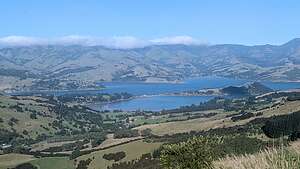 Along the drive to AkaroaI think it was a pretty bold move on our part to take on the sea to sea drive on our last day with the campervan.
Along the drive to AkaroaI think it was a pretty bold move on our part to take on the sea to sea drive on our last day with the campervan.
Starting at Punakaiki Beach Camp on the Tasman Sea in the morning, we drove down the West Coast and then onto the Great Alpine Highway over Arthur’s Pass, and then onto Highway 75, a steep twisty road that crosses the hilly terrain of the Banks Peninsula, before steeply descending into the lovely town of Akaroa on the South Pacific Sea.
If we had known how steep and windy the road to Akaroa was, we might have thought twice about doing this. I’m glad we were so uninformed, because Akaroa turned out to be worth every white-knuckling mile.
.thumbnail.jpg) View of Akaroa Harbor from our campsiteWe camped at another Top 10 Holiday Park, which is kind of like the KOA of New Zealand - great facilities that you can depend on. It would be our 5th night staying in one this trip.
View of Akaroa Harbor from our campsiteWe camped at another Top 10 Holiday Park, which is kind of like the KOA of New Zealand - great facilities that you can depend on. It would be our 5th night staying in one this trip.
This one at location, location, location - overlooking the Akaroa Harbor and in walking distance to town, where there were plenty of restaurants, cafes, and shops.
After parking the campervan in our site, we walked down the steep road into town and strolled along the Rue Lavaud, Akaroa’s Main Street, looking for a place to eat.
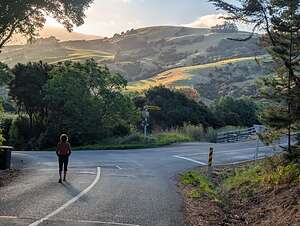 The walk to townHmm…All the streets were called Rue something. Sounded a bit French to me, and it turns out that the French did play a role in the settlement of this village.
The walk to townHmm…All the streets were called Rue something. Sounded a bit French to me, and it turns out that the French did play a role in the settlement of this village.
The Maori had established a settlement here more than 700 years ago, drawn by the sheltered harbor and abundant resources. They were the ones that gave the village the name “Akaroa,” which means “Long Harbor.” They still have a presence in the community, but only make up about 6% of the population.
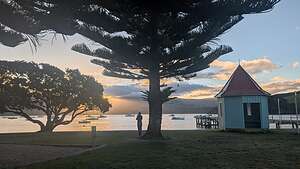 View from our dinnerThen in 1838, a French whaler named Captain Langlois, arrived, believing he had purchased the Banks Peninsula from the Maori.
View from our dinnerThen in 1838, a French whaler named Captain Langlois, arrived, believing he had purchased the Banks Peninsula from the Maori.
In 1840, a group of French settlers sailed to Akaroa on the ship “Comte de Paris,” led by Captain Charles Lavaud. Their intention was to create a French colony in the South Island.
Oh, so that’s why the Main Street is name Rue Lavaud.
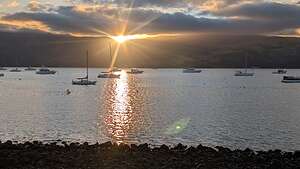 Sunset over Akaroa HarborUnfortunately for the French settlers, they were a little late. The Treaty of Waitangi had already been signed by the Maori and the British, making the South Island a colony of Britain.
Sunset over Akaroa HarborUnfortunately for the French settlers, they were a little late. The Treaty of Waitangi had already been signed by the Maori and the British, making the South Island a colony of Britain.
Despite this the French settler remained, often intermarrying with the British, so it has remained a unique French settlement within New Zealand.
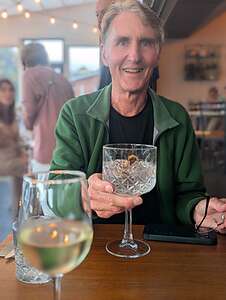 Dinner at Ma MaisonBy the time we got into town at 7:30, most of the restaurants were closing soon. Fortunately, we found one that was open to 9:00, and it was perfect - French name (Ma Maison), beautiful location on Beach Road overlooking the Harbor, and excellent food.
Dinner at Ma MaisonBy the time we got into town at 7:30, most of the restaurants were closing soon. Fortunately, we found one that was open to 9:00, and it was perfect - French name (Ma Maison), beautiful location on Beach Road overlooking the Harbor, and excellent food.
Herb had a delicious filet mignon and I had Crispy Glazed Tamarind Eggplant and Seared Scallops.
Not sure which was better - the food or the view from our table.
We had enjoyed the town so much that the next morning before driving back up the crazy road to Christchurch to return the campervan, we parked near the Akaroa Freedom Campsite near the Boat Park and walked from there.
.thumbnail.jpg) Peninsula War MemorialI kind of wish we had known about this Freedom Camp last night, because besides it being free, it was right on the water and much closer to town. Oh well. The Top 10 Holiday Park and nice showers and an RV dump, which we had to use because we needed to return the campervan empty.
Peninsula War MemorialI kind of wish we had known about this Freedom Camp last night, because besides it being free, it was right on the water and much closer to town. Oh well. The Top 10 Holiday Park and nice showers and an RV dump, which we had to use because we needed to return the campervan empty.
From the Freedom Campsite, we strolled back up Rue Lavaud, looking for potential breakfast places along the way. So far, The Common was winning.
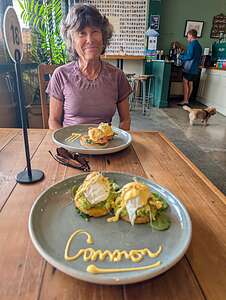 Yummy Eggs Benedict with SalmonContinuing along the Rue Lavaud, we eventually came to the Peninsula War Memorial, an elaborate, free-standing cupola, complete with flying buttresses and a granite spire, located at the center of a garden, guarded by tall palm trees.
Yummy Eggs Benedict with SalmonContinuing along the Rue Lavaud, we eventually came to the Peninsula War Memorial, an elaborate, free-standing cupola, complete with flying buttresses and a granite spire, located at the center of a garden, guarded by tall palm trees.
It is dedicated to the men of the Banks Peninsula who died in World War I, World War II, and the African War, whose names are engraved on granite tablets inside the cupola.
Then it was back to The Common, a popular cafe and garden bar on Rue Lavaud that serves brunch.
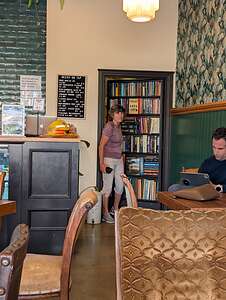 Secret door at The CommonI had to have eggs benedict with salmon and spinach one more time before I left New Zealand.
Secret door at The CommonI had to have eggs benedict with salmon and spinach one more time before I left New Zealand.
Herb had the hash and eggs, but counted it as a vegetable because it had spinach and avocado.
Before leaving, I asked where the restroom was - actually they use the word toilet instead. I was told that it was behind the bookcase. Hmm? Sure enough, I glanced to my right and saw a tall bookcase. I pushed on it, and sure it was a secret door.
Very cool place and the food was great.
All good things must come to an end, and I guess this was it. Well, actually we still had the challenging, but stunning, drive back up and down windy, hilly Highway 75 to Christchurch to return the Campervan at Wilderness Motorhome Rentals.
Then it was a night in Sudima Airport Hotel and the long flight home to San Francisco.
What a great trip it had been, but we were pretty ready to get back home..
Arthur's Pass and Castle Hill
Monday, February 24, 2025 - 9:15am by Lolo100 miles and 1 hour from our last stop
Travelogue
 Along the Great Alpine HighwayWe were nearing the end of our journey - just one more night in the campervan before we needed to return it to Wilderness Motorhome Rentals in Christchurch.
Along the Great Alpine HighwayWe were nearing the end of our journey - just one more night in the campervan before we needed to return it to Wilderness Motorhome Rentals in Christchurch.
Back in Queenstown, we had made the decision to turn our 14-day adventure into a loop up the West Coast and back to Christchurch, rather than an out-and-back.
So, this would require us driving over the Southern Alps for a second time, the first being the drive from Wanaka to the West Coast (Tasman Sea) over Haast Pass, and now back across the Southern Alps from the West Coast to Christchurch along the Great Alpine Highway (also known as HIghway 73), one of the South Island’s most iconic roads - 150 miles of mountains, stunning rivers, weird rock formations, and quirky towns.
 Approaching Castle Hill RocksOriginally, we thought we would spend our last night in the campervan somewhere along the Great Alpine Highway, but then we got it in our heads that it would be really cool to do a coast to coast drive from Pancake Rocks on the Tasman Sea all the way across to the town of Akaroa on the South Pacific Ocean.
Approaching Castle Hill RocksOriginally, we thought we would spend our last night in the campervan somewhere along the Great Alpine Highway, but then we got it in our heads that it would be really cool to do a coast to coast drive from Pancake Rocks on the Tasman Sea all the way across to the town of Akaroa on the South Pacific Ocean.
But first we had to get up and over Arthur’s Pass.
Now that we had decided to go all the way to Akaroa today we limited our stops along the Great Alpine Highway to just the one that most intrigued us - the Castle Hill rock formations.
 Castle HillWe got a little confused finding the trailhead and pulled into the Village of Castle Hill by mistake before checking All Trails and finding that the hike actually begins at the Kura-Tawhiti Access Track just a few miles past the village.
Castle HillWe got a little confused finding the trailhead and pulled into the Village of Castle Hill by mistake before checking All Trails and finding that the hike actually begins at the Kura-Tawhiti Access Track just a few miles past the village.
From the parking area, we walked along a dirt road toward a cluster of weird rock formations, rising from the landscape like ancient, weathered sculptures, or perhaps an old ruined castle. We really could go wild with our imagination here.
 Castle Hill weird rock formationsI could see why it was used as a filming location for the magical land of Narnia in "The Chronicles of Narnia: The Lion, the Witch and the Wardrobe."
Castle Hill weird rock formationsI could see why it was used as a filming location for the magical land of Narnia in "The Chronicles of Narnia: The Lion, the Witch and the Wardrobe."
Upon reaching the boulders, we followed the track around them and sometimes wandered in and amongst them along a natural maze with a confusing network of passages, hidden corners and dead ends.
 Castle Hill rock formationsWe found ourselves surrounded by these massive limestone boulders, each with its own shape and character. It was like finding animals and other shapes in the clouds. I was convinced that one of them looked just like a hamster, or maybe it was a rabbit. We were in New Zealand, so perhaps it was a Wallaby.
Castle Hill rock formationsWe found ourselves surrounded by these massive limestone boulders, each with its own shape and character. It was like finding animals and other shapes in the clouds. I was convinced that one of them looked just like a hamster, or maybe it was a rabbit. We were in New Zealand, so perhaps it was a Wallaby.
How did these unique limestone formations come to be? Well, pretty much the same way that the Pancake Rocks did:
 Castle Hill Maze30 million years ago this area was covered by an ancient inland sea, where over time marine organisms on the seabed were compressed into limestone
Castle Hill Maze30 million years ago this area was covered by an ancient inland sea, where over time marine organisms on the seabed were compressed into limestone
The inland ocean receded and the collision of tectonic plates lifted up the limestone and surrounding land
Forces of erosion (wind and water) went to work, sculpting the rock into the distinctive shapes we were enjoying today.
 Maori "pou whenua"I was really getting to appreciate the beauty that limestone + erosion can create. Nature is a wonderful artist.
Maori "pou whenua"I was really getting to appreciate the beauty that limestone + erosion can create. Nature is a wonderful artist.
On the way back to the parking lot, we noticed three large carved wooden posts with the bust (from shoulder up) of a Maori man with a feather on his head. They represent three ancestors of the Ngāi Tahu tribe, which is the principal Maroi tribe on the South Island.
These posts (or "pou whenua" in Maori) serve as markers of territorial boundaries and their cultural connection to Kura Tawhit (the land we were currently on). Perhaps that is why they are looking in three different directions.
My one regret this trip is not learning more about the Maori people, who were New Zealand’s first inhabitants, having arrived from Eastern Polynesia in canoes around 1250 CE. Like the Native Americans in the U.S., they had a rich and complex society before the arrival of European settlers in 1840.
In recent decades, there has been a resurgence of Māori culture and language, and a growing recognition of Māori rights and interests. Today they make up about 20% of the population of New Zealand..
Pancake Rocks and Punakaiki Beach
Sunday, February 23, 2025 - 1:00pm by Lolo88 miles and 1.25 hours from our last stop - 1 night stay
Travelogue
 Pancake RocksAfter a delicious fish and chips in Hokitika, we got back in the campervan and drove north along the coast to the Punakaiki sea stacks, more popularly known as the Pancake Rocks.
Pancake RocksAfter a delicious fish and chips in Hokitika, we got back in the campervan and drove north along the coast to the Punakaiki sea stacks, more popularly known as the Pancake Rocks.
These intriguing rock formations can best be seen along the easy, 0.75-mile Pancake Rocks and Blowholes Track at Dolomite Point, near Punakaiki Village.
The short 0.75 track winds through native forest, with beautiful views of the Tasman Sea on its way to the “pancakes.”
I always find it more interesting to view rock formations when I have a better understanding as to how they got that way.
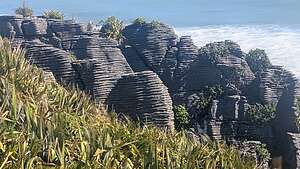 Pancake RocksSo, besides being beautiful to look at, these “pancakes” had a story to tell, and one that is 30 million years old.
Pancake RocksSo, besides being beautiful to look at, these “pancakes” had a story to tell, and one that is 30 million years old.
Once upon a time, this entire area was submerged beneath the sea, where tiny fragments of marine creatures and plants accumulated on the seabed.
Millions of years of Immense water pressure caused these fragments to solidify, forming layers of alternating harder limestone and softer mudstone.
.thumbnail.jpeg) Punakaiki Blow HoleOver time, seismic activity lifted the limestone formations above sea level, where they were then exposed to millions of years of erosion from wind, rain, and waves.
Punakaiki Blow HoleOver time, seismic activity lifted the limestone formations above sea level, where they were then exposed to millions of years of erosion from wind, rain, and waves.
The "pancake" effect is due to alternating layers of harder limestone and softer mudstone, which erode at different rates.
The End, or at least in our lifetimes. Who knows what they will look like in another 30 million years.
Along the walk there was also a Blowhole. Like the “pancakes,” blowholes are also created by the sea eroding the limestone, but in this case, they form vertical shafts.
When the tide is high and there is a large swell, the water is forced up through the shaft, creating a geyser-like spray.
 Punakaiki Beach sea stackAfter completing the walk, we drove on to the Punakaiki Beach Camp, where we would be staying for the night.
Punakaiki Beach sea stackAfter completing the walk, we drove on to the Punakaiki Beach Camp, where we would be staying for the night.
Talk about location!! We’ve had some very scenic campgrounds before, but this one was right on Punakaiki Beach with surfers and sea stacks.
 Punakaiki Beach Sea StackAs we walked along the beach north towards the large sea stack in the distance, I noticed children playing in the Pororari River that was meandering down towards that sea stack I was heading towards.
Punakaiki Beach Sea StackAs we walked along the beach north towards the large sea stack in the distance, I noticed children playing in the Pororari River that was meandering down towards that sea stack I was heading towards.
I followed the river to its mouth, where it flowed into the Tasman Sea, and found my sea stack just on the other side or the river. I very briefly toyed with taking off my shoes, rolling up my pant legs, and crossing over to the sea stack for a closer look, but decided it probably wasn’t the wisest thing to do.
 Surfer off Punakaiki BeachBesides the view of it was better from this side, with the river flowing by in the foreground.
Surfer off Punakaiki BeachBesides the view of it was better from this side, with the river flowing by in the foreground.
Later that evening after dinner, we returned to the beach to watch the sunset.
It would have been absolutely perfect, if it hadn’t been for the sandflies, which are all over the South Island, but especially along the West Coast. I had been dealing with them most of the trip and have welts on my legs to bring home as a souvenir.
A local that I asked how he dealt with them, told me they didn’t bother him. It just takes 10,000 bites to become immune to them. I told him that I think I was close.
 Sunset from Punakaiki BeachHe said that if I wanted a shortcut reaching 10,000, I should just put out a glass of red wine outside at night and the next morning just drink the 50 or so that had drowned in it.
Sunset from Punakaiki BeachHe said that if I wanted a shortcut reaching 10,000, I should just put out a glass of red wine outside at night and the next morning just drink the 50 or so that had drowned in it.
I have a funny feeling that he was just trying to get the American tourist to do something foolish. I did google it afterwards and the part about using red wine to trap him is legit, but nothing mentioned actually drinking it. I think I’ll stick with my benadryl cream.
The evening was so lovely that I put sand flies out of my mind and just watched the sun set beneath the horizon on the Tasman Sea..
Hokitika
Saturday, February 22, 2025 - 8:30pm by Lolo95 miles and 2 hours from our last stop - 1 night stay
Travelogue
 Hokitika driftwood welcomeWhenever I travel to a new place, I enjoy reading a novel that takes place there.
Hokitika driftwood welcomeWhenever I travel to a new place, I enjoy reading a novel that takes place there.
When we went to Iceland, I read “Independent People" by Halldór Laxness about the struggles of poor Icelandic farmers in the early 20th century.
For my trip to New Zealand, I brought along “The Luminaries” by Eleanor Catton, a complex mystery set in Hokitika during the 1866 gold rush.
 Off to feed the eelsIt kind of makes me feel more connected to the place.
Off to feed the eelsIt kind of makes me feel more connected to the place.
We wouldn’t be getting all the way into the town of Hokitika tonight, but rather just on the southern side of the Hokitika River in a little campground called Links View Holiday Park.
Unlike the large Top 10 Holiday Parks we had been staying in so far, this was a small campground run by one very friendly host. When we pulled into the campground, he came out to greet us and spent a good half hour talking to us about the craziness of politics in the United States.
 Giant longfin eelOnce he got that out of his system, he took us inside a very cozy sitting room and kitchenette and showed us the eggs, beer, and wine we could purchase from his refrigerator.
Giant longfin eelOnce he got that out of his system, he took us inside a very cozy sitting room and kitchenette and showed us the eggs, beer, and wine we could purchase from his refrigerator.
He was very ready to continue talking to us all night, but we channeled his energy into telling us where we could get good fish and chips in town tomorrow (Hokitika is known for its fish and chips) and where we could park our campervan.
After providing that information, he told us that we should really take the short walk down to the river to see and feed the giant longfin eels. Oh cool. We told him that we had seen these in the Avon River in Christchurch, but he informed us that these eels were much bigger.
 Turquoise blue waters of Hokitika GorgeHe suggested we bring some bread and then further added that one almost took the skin off his granddaughter’s finger. Great. Sounded like fun.
Turquoise blue waters of Hokitika GorgeHe suggested we bring some bread and then further added that one almost took the skin off his granddaughter’s finger. Great. Sounded like fun.
I went down first to see if there were any eels hanging around. Oh boy! I immediately went back and told Herb he had to see this. They were pretty big and more plentiful than what we had seen in Christchurch.
We threw some bread, took some photos, and returned to the campervan for dinner, all 20 fingers intact.
 Turquoise blue waters of Hokitika GorgeThe next morning before heading into town, we drove south about 18 miles through lovely farmland to the parking area for the very popular Hokitika Gorge hike, known for its incredibly vibrant turquoise blue water.
Turquoise blue waters of Hokitika GorgeThe next morning before heading into town, we drove south about 18 miles through lovely farmland to the parking area for the very popular Hokitika Gorge hike, known for its incredibly vibrant turquoise blue water.
The hike used to be a 1.3-mile loop with two suspension bridges, but in October 2013, the lower suspension bridge was closed due to safety concerns about its structural integrity.
So today, it is a 2-mile out-and-back, the best direction being clockwise, to a rocky outcrop protruding out into the gorge, with the best view of its brilliant blue waters.
 Hokitika GorgeTo get down to the rocks we went through a gate with a warning sign about the dangers of swimming and slippery rocks, and then did a bit of rock scrambling to reach the very end of the outcrop.
Hokitika GorgeTo get down to the rocks we went through a gate with a warning sign about the dangers of swimming and slippery rocks, and then did a bit of rock scrambling to reach the very end of the outcrop.
It’s a great spot to both take a photo and be in a photo, but we weren’t the only ones with this idea in mind, so we politely waited our turn.
We’ve seen a lot of beautiful turquoise blue lakes and rivers this trip, but this and Lake Pukaki were by far the most vibrant.
 Hokitika GorgeAnd to think it was all the result of sunlight hitting “glacial flour,” which are finely ground rock particles created by the grinding action of glaciers.
Hokitika GorgeAnd to think it was all the result of sunlight hitting “glacial flour,” which are finely ground rock particles created by the grinding action of glaciers.
There is not one single glacier that “flours” the Hokitika Gorge. Rather, the “flour” is carried by meltwater from several glaciers in the surrounding Alps, which feed numerous streams, which in turn feed the Hokitika River, which flows through this beautiful gorge.
 Shipwreck MemorialThe particles get suspended in the water and reflect the sunlight. Fortunately, we had plenty of sunlight today, so we were seeing it at its best.
Shipwreck MemorialThe particles get suspended in the water and reflect the sunlight. Fortunately, we had plenty of sunlight today, so we were seeing it at its best.
It was a great hike with a lot of bang for the buck.
Now, it was on to the town of Hokitika, known for having the best fish and chips on the South Island.
 Hokitika Driftwood ArtWe parked at Sunset Point, where the Hokitika River flows out into the Tasman Sea. This was a very dangerous port during the 1860s Gold Rush, with more than 42 ships wrecked trying to cross the Hokitika River’s shifting sandbar.
Hokitika Driftwood ArtWe parked at Sunset Point, where the Hokitika River flows out into the Tasman Sea. This was a very dangerous port during the 1860s Gold Rush, with more than 42 ships wrecked trying to cross the Hokitika River’s shifting sandbar.
A plaque memorializing these wrecks stood next to a reconstruction of the schooner Tambo, which was wrecked on this Bar on November 12, 1866.
 Hokitika Driftwood ArtThe history of shipwrecks in Hokitika is deeply intertwined with the town's origins as a bustling gold rush port.
Hokitika Driftwood ArtThe history of shipwrecks in Hokitika is deeply intertwined with the town's origins as a bustling gold rush port.
This was all very exciting for me to see in person, because I was still deep in my novel, The Luminaries, which is about Hokitika during the gold rush - shipwrecks and all.
couldn’t wait to walk up Revell Street where the whorehouses and the bars where the diggers hung out used to be.
 Hokitika Driftwood ArtFrom the Shipwreck Memorial we walked out onto Hokitika Beach, known for its driftwood art. The beaches around Hokitika naturally accumulate large amounts of driftwood providing lots of raw materials for driftwood artists.
Hokitika Driftwood ArtFrom the Shipwreck Memorial we walked out onto Hokitika Beach, known for its driftwood art. The beaches around Hokitika naturally accumulate large amounts of driftwood providing lots of raw materials for driftwood artists.
Every end of January, Hokitika holds a week long Driftwood and Sand Festival where artists and members of the public create sculptures and art pieces using driftwood and other materials found on the beach.
 Hokitika Driftwood ArtMuch of the festival works remained, so we had a great time strolling up the beach, admiring the many unique and imaginative creations.
Hokitika Driftwood ArtMuch of the festival works remained, so we had a great time strolling up the beach, admiring the many unique and imaginative creations.
At the end of the beach, we came to a HOKITIKA sign made of driftwood, not far from Stumper’s Bar and Cafe, where we planned to have lunch.
Although they didn’t call it fish and chips, we had a delicious beer battered grilled fish fillet and fries - our definition of fish and chips. It was delicious.
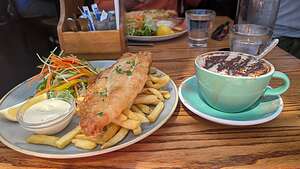 Lunch at Stumper'sHerb surprised me with a large mochaccino. Now that’s a man that knows my three great loves - coffee, chocolate, and a man that brings me one.
Lunch at Stumper'sHerb surprised me with a large mochaccino. Now that’s a man that knows my three great loves - coffee, chocolate, and a man that brings me one.
Hokitika had certainly delivered - giant eels, a beautiful hike to Hokitika Gorge, driftwood art alongside the Tasman Sea, and a delicious fish and chips lunch.
Time to move on though. Tonight Pancake Rocks and Punakaiki Beach.
I was feeling pretty smug as to how efficiently we were covering a lot of ground and seeing and doing everything we had hoped to accomplish.
Fox Glacier
Friday, February 21, 2025 - 6:45pm by Lolo228 miles and 5 hours from our last stop - 1 night stay
Travelogue
 Lake Hawea along the way to Fox GlacierToday was going to be a very long driving day for us to get to Fox Glacier, where we had booked a Heli-Hiking tour with Fox Glacier Guiding for tomorrow morning. But more on that later. First we had to get there.
Lake Hawea along the way to Fox GlacierToday was going to be a very long driving day for us to get to Fox Glacier, where we had booked a Heli-Hiking tour with Fox Glacier Guiding for tomorrow morning. But more on that later. First we had to get there.
The drive from Queenstown to Fox Glacier was 6.5 hours, our longest driving day to date. However, we had planned a few breaks along the way.
The first hurdle was to get back to Wanaka without going over the crazy Crown Range road, which we had taken on our way down. Campervans are not even supposed to be on that road, but that is the way Google Maps had sent us. I hate when it does that.
 Dune LakeInstead we took a slightly less scenic, but still very pretty, ride along Route 6 back to Wanaka. After Wanaka, the ride became even more scenic, tracing the western shores of Lake Hawea, where we had e-biked a few days ago.
Dune LakeInstead we took a slightly less scenic, but still very pretty, ride along Route 6 back to Wanaka. After Wanaka, the ride became even more scenic, tracing the western shores of Lake Hawea, where we had e-biked a few days ago.
Then Route 6 took us across the “The Neck,” which is the narrow strip of land 1 km wide that separates Lake Hawea and Lake Wanaka. It’s also a scenic viewpoint with stunning views of both lakes.
Once across The Neck, we were now tracing the eastern shores of the northern part of Lake Wanaka.
 The Tasman Sea!Continuing on, we passed through Makarora, the gateway to Mount Aspiring National Park, which we unfortunately would not be visiting this trip.
The Tasman Sea!Continuing on, we passed through Makarora, the gateway to Mount Aspiring National Park, which we unfortunately would not be visiting this trip.
After that, we turned west towards the coast, going over Haast Pass, one of the three main roads that cross the Southern Alps. Later on this trip, we would be crossing back across the Alps to Christchurch along Arthur’s Pass.
We had already been driving over 3 hours, so we stopped at Ship Creek, in the Tauparikaka Marine reserve.
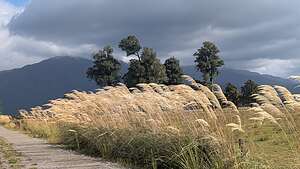 Trailhead for Lake Matheson HikeThe name "Ship Creek" comes from the discovery of wreckage from the SS Schomberg, a clipper ship that wrecked, not here, but rather off the coast of Victoria, Australia, in 1855. However, pieces of the wreckage drifted all the way across the Tasman Sea from Australia and washed up on what is now called Ship Creek.
Trailhead for Lake Matheson HikeThe name "Ship Creek" comes from the discovery of wreckage from the SS Schomberg, a clipper ship that wrecked, not here, but rather off the coast of Victoria, Australia, in 1855. However, pieces of the wreckage drifted all the way across the Tasman Sea from Australia and washed up on what is now called Ship Creek.
We decided to stretch our legs on the Dune Lake Walk, which starts from the Ship Creek visitor shelter. From there, it follows a boardwalk behind the dunes through a beautiful section of wind-stunted coastal rainforest before coming to a platform looking over Dune Lake.
 Lake Matheson HikeAfter continuing to another viewpoint above the beach, we headed down to the beach itself to experience closeup the pounding of the surf from the Tasman Sea.
Lake Matheson HikeAfter continuing to another viewpoint above the beach, we headed down to the beach itself to experience closeup the pounding of the surf from the Tasman Sea.
From here, it was less than an hour and a half to go to Fox Glacier.
When we got to Fox Glacier, we stopped in town to see where we were supposed to meet for our heli-hike tour with Fox Glacier Guiding tomorrow morning and where we were supposed to park our campervan. No problem. There was a big lot right nearby.
 Lake Matheson sans reflectionsWe then checked into the Fox Glacier Top 10 Holiday Park, which was less than a mile from Fox Glacier Guiding.
Lake Matheson sans reflectionsWe then checked into the Fox Glacier Top 10 Holiday Park, which was less than a mile from Fox Glacier Guiding.
Rather than pull into our campsite, we drove 3 miles to the Lake Matheson Trailhead, one of the hikes on our to do list. Lake Matheson is known for its stunning reflections of Mount Cook, but that only occurs when the conditions are just right - still water and clear skies.
Unfortunately, today was very cloudy, so we couldn’t even see the real Mount Cook, nevermind its reflection. Still it was a very nice hike.
 Helicopter 1, Passenger 1The next morning we headed over to Fox Glacier Guiding to make sure we could get a good parking space. We were early so walked across the street to the Cafe Neve for an eggs benedict breakfast - my New Zealand go-to.
Helicopter 1, Passenger 1The next morning we headed over to Fox Glacier Guiding to make sure we could get a good parking space. We were early so walked across the street to the Cafe Neve for an eggs benedict breakfast - my New Zealand go-to.
Then we went back to Fox Glacier Guiding for our orientation, where we watched a movie on both helicopter and glacier safety. We were told that the helicopters could not fly through the clouds, so there was the very slight possibility that we would have to sleep on the glacier. Tents and sleeping bags would be provided. This, however, had not happened since 2019.
I Incoming helicopter quickly texted both my sons to tell them if they didn’t hear from me tonight, not to worry. I’m sleeping on the glacier. I sounded so cool.
Incoming helicopter quickly texted both my sons to tell them if they didn’t hear from me tonight, not to worry. I’m sleeping on the glacier. I sounded so cool.
After that, we were each given boots (crampons would be given out later when we were on the glacier), wool socks, weatherproof pants and jackets, hats, gloves, and a trekking pole.
There were 22 of us to be divided up into four helicopters, each of which could carry 6 passengers.
 And off we go...When booking the trip, we had to give our weight. There was an individual weight restriction of 256 lbs, and an overall helicopter weight restriction of 1,050 lbs. So that’s why they wanted to know our weights when we booked the trip.
And off we go...When booking the trip, we had to give our weight. There was an individual weight restriction of 256 lbs, and an overall helicopter weight restriction of 1,050 lbs. So that’s why they wanted to know our weights when we booked the trip.
A lot of calculating was done to divide us into helicopters, and even what seats we would sit in. Our group of 6 was assigned to Helicopter 1. Since I was the lightweight, I got to sit up front with the pilot with one other girl, and specifically was told to sit in the window seat. Helicopter 1, Passenger 1. Fine with me. I was becoming cooler every minute.
 Fox GlacierThe helicopter ride was relatively short, taking us below the clouds through a valley to the foot of 13-km long Fox Glacier. Along the way, we passed lovely Victoria Falls, which is the melt river from the hidden Victoria Glacier.
Fox GlacierThe helicopter ride was relatively short, taking us below the clouds through a valley to the foot of 13-km long Fox Glacier. Along the way, we passed lovely Victoria Falls, which is the melt river from the hidden Victoria Glacier.
After landing, we followed our safety instructions as to how to exit the helicopter, which basically was common sense - keep head and appendages away from the blades.
We then gathered as a group on a set of benches where we were given our crampons and instructions as to how to put them on and how to best walk with them.
 Our first ice caveWe also were offered a trekking pole, which I took for more stability.
Our first ice caveWe also were offered a trekking pole, which I took for more stability.
As each of the remaining helicopters in our group came in, we were all instructed to get down on one knee, put our heads down, and cover our faces, because those chopper wings really created quite a wind.
Once all 4 helicopters had arrived and everyone had their crampons on, we split into two groups, each of which had their own guide.
 Lolo in her ice caveOur guide was Campbell, and he sized me up right away as the one to keep an eye on. He was very diligent, always making sure I didn’t fall in a crevasse or something.
Lolo in her ice caveOur guide was Campbell, and he sized me up right away as the one to keep an eye on. He was very diligent, always making sure I didn’t fall in a crevasse or something.
We then set out in a line behind Campbell, who told us that our landing spot was on a part of the glacier where its forces work hardest and that today we would explore some spectacular, brilliantly blue ice caves, arches, and tunnels.
 Fox GlacierHowever, he did add that Fox Glacier is a very dynamic glacier, constantly changing, so he couldn’t be totally sure exactly what features we would see today.
Fox GlacierHowever, he did add that Fox Glacier is a very dynamic glacier, constantly changing, so he couldn’t be totally sure exactly what features we would see today.
The reason for its dynamism is that it is a temperate maritime glacier as opposed to a polar glacier. Maritime because it is located close to the Tasman Sea and temperate because its climate is relatively mild with large amounts of precipitation, often in the form of snow.
Therefore, the ice within Fox Glacier is at or near its melting point, in contrast to polar glaciers, which remain frozen year-round, making them more susceptible to rapid changes in their flow and shape.
New features appear all the time and old features disappear. So, we would see what we would see.
 Lolo showing off her rope skillsThe guides were great. They would run ahead and scout out the terrain for its safety and stability, making sure there were no crevasses and ground that would give way.
Lolo showing off her rope skillsThe guides were great. They would run ahead and scout out the terrain for its safety and stability, making sure there were no crevasses and ground that would give way.
In areas where we would descend into a cave or tunnel they would put in ice screws as anchors and then run a climbing rope through them for us to use as a sort of handrail to keep us from falling.
 Glacial PoolProper placement of ice screws is critical and can only be safely done by an experienced glacier guide who must ensure that he chooses solid ice, angles the screw correctly, and ensures the screw is fully engaged and held in tight.
Glacial PoolProper placement of ice screws is critical and can only be safely done by an experienced glacier guide who must ensure that he chooses solid ice, angles the screw correctly, and ensures the screw is fully engaged and held in tight.
Herb was very familiar with the importance of good ice screw placement from his old ice climbing days about 40 years ago and saw that Campbell was checking and rechecking his screw placement.
.thumbnail.jpg) I love Fox GlacierThey were definitely a necessity for climbing down into and back out of an ice cave.
I love Fox GlacierThey were definitely a necessity for climbing down into and back out of an ice cave.
After the ice caves, Campbell led us to a beautiful glacial pool with vibrantly blue water, so blue it was hard to believe it was natural and there is a scientific explanation for it that involves both physics and the properties of ice.
Glacial ice is very dense and has very few air bubbles. When sunlight enters the ice, the ice absorbs the longer wavelengths of light (red, orange, and yellow) but the shorter wavelengths (blue) penetrate deeper and then scatters. The deeper the sunlight travels into the ice, the more the other colors are absorbed, and the more intense the blue appears.
.thumbnail.jpg) Back to the Mother ShipWhatever the explanation was, it was beautiful.
Back to the Mother ShipWhatever the explanation was, it was beautiful.
I couldn’t believe our 3 hours of glacier time was almost over. It had gone so quickly. Campbell led us back to the landing pad, where we took off our crampons and learned how to fold them like a burrito. My burrito looked more like an enchilada so Herb had to help.
Then Helicopter 1 arrived (our ride) and we boarded. I offered Passenger 2 my window seat and was told that everybody’s weight was probably analyzed for weight distribution and I still had to sit by the window. Good. I wanted to anyway. I was just being polite.
 Braided River from Fox GlacierIt was a totally different view flying down from the glacier back to the town of Fox Glacier. Rather than watching the glacier get closer and closer, we were now getting a good aerial look at the braided pattern of runoff from the terminus of the glacier we had just left.
Braided River from Fox GlacierIt was a totally different view flying down from the glacier back to the town of Fox Glacier. Rather than watching the glacier get closer and closer, we were now getting a good aerial look at the braided pattern of runoff from the terminus of the glacier we had just left.
These braided rivers are formed from the high volume of sediment carried downstream by meltwater. The combination of high sediment load and variable flow results in the formation of shallow, interwoven channels, forming lovely patterns.
Before we knew it, we were back at the Fox Glacier Guiding building turning in our boots, socks, jacket, pants, etc.
Time to move on to the next stop along our journey up the South Island’s western coast - Hokitika, about 2 hours and 15 minutes away. We had quite an aggressive, but manageable, itinerary, and we were getting to see so much of this amazing country.
